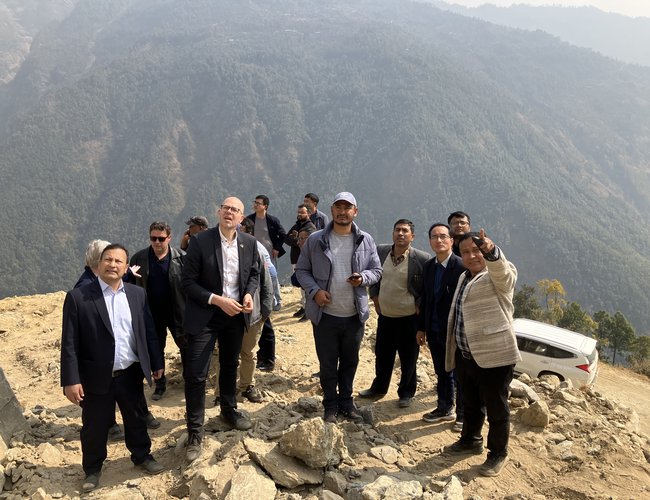
As a high-level delegation led by Peteris Ustubs, Director for Asia, Central Asia, Pacific, and the Middle East at the European Union, examined the construction of a 220 kV transmission line project with Kul Man Ghising, Managing Director of the Nepal Electricity Authority, the delegation became aware of the difficulties presented by harsh mountainous terrains.
Although it is a difficult project that traversed mountains higher than 8000 feet, the 220 kV Transmission line project is crucial strategically and will serve as a lifeline to evacualte the hydroelectricity produced by hydropower projects from the area.
The contract was signed in the final year of his first year of tenure and has been inactive for about a year throughout his absence. Ghising announced that all transmission lines which are under construction, including the 220 kV Chilime-Trishuli Transmission line, would be finished.
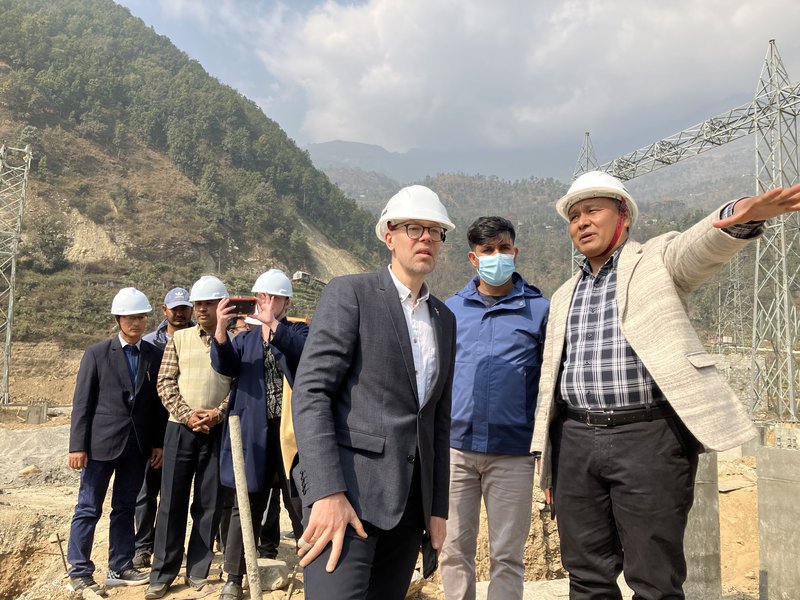
This transmission line project, which is being constructed with EU assistance, will significantly help to reduce the use of fossil fuels, especially LPG. MD Ghising, who has been working arduously to complete the project before June, gave an update on its condition while touring the site with a high-level European group.
The transmission project, which was delayed for about two years due to the COVID-19 Pandemic and difficult geology and steep terrain, is back on schedule. The project is currently on track to be completed by the amended deadline of June 2023, according to MD Ghising.
The EU delegation appears satisfied after inspecting the construction sites and working with MD Ghising. At a time when rising fuel prices, including LPG, are causing concern in Nepal.
Upper Sanjen, Sanjen, and Rashuwagadhi projects are nearing completion. "Opportunities and challenges for renewable energy: delighted to have Peteris Ustubs in Nepal visiting with NEA @KulmanGhising and partners," EU in Nepal tweets.
A high-level European Union team conducted an on-site inspection of the Chilime-Trishuli 220 kV transmission line project, which is currently under construction.
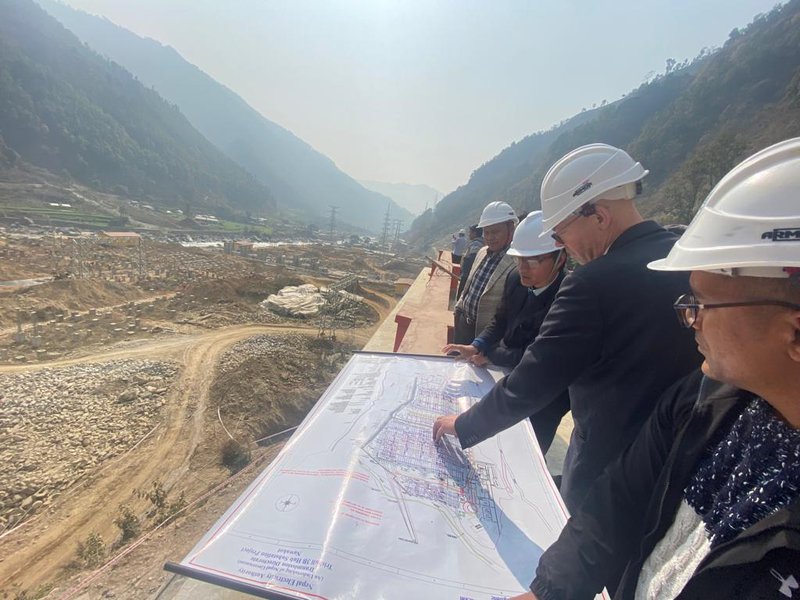
On Monday, a group led by Peteris Ustubs, Director for Asia, European Union, paid visits to the projects being built in Nuwakot and Rasuwa (February 6).
A 220/132/33 kV Chilime Hub substation and a Trishuli 3B Hub substation are being built as part of the project at Thambuchet in the Amachodingmo Rural Municipality of Rasuwa and Pahrebensi in the Kispang Rural Municipality of Nuwakot.
A 28 km 220 kV transmission line connecting Chilime hub and Trishuli 3B hub substation is also being built.
The project is estimated to cost 30.9 million US dollars, with investments from the government and the Nepal Electricity Authority, as well as a grant from the German Development Bank (KFW).
Concessional loans are available through the European Union's European Investment Bank (EIB) project. According to the Ghising, a high-level EU team inspected the Trishuli 3B hub substation and transmission line under construction at Dandagaun, which is located in Uttargaya Rural Municipality-2 of Rasuwa.
The team met with Nepal Electricity Authority, project management, consultants, and contractors involved in the construction to discuss a variety of issues, including the project's progress, problems, and completion date.
The project's construction has recently picked up speed, according to team leader Peteris Ustubs, and the progress made thus far is satisfactory, according to Kul Man Ghising, managing director of the NEA, who went on a site inspection with the team.
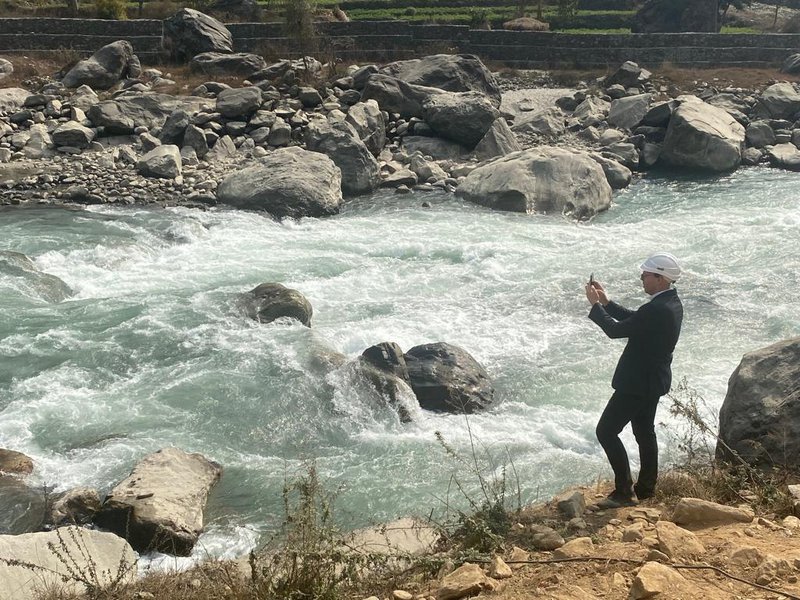
The COVID-19 epidemic, the project's problematic location in a mountainous environment, and the contractors' and consultants' subpar performance all had an impact on the construction process.
According to Ghising, "in the past, they expressed concern about the construction's delay, but during the inspection visit, the team expressed their happiness and appreciated the fact that the work has picked up momentum and made significant progress, and the project is being carried out in a geographically very dangerous and difficult Himalayan region.
Through the EIB, the European Union is attempting to make significant investments in Nepal's hydropower production, transmission, and distribution, he claimed.
It has stated a desire to contribute to the 635 MW Dudhkoshi Reservoir project through foreign financial institutions' co-financing.
The EIB has also offered concessional loans for the 140 MW Tanahun Hydropower Project, the 220 kV Marsyangdi Corridor Transmission Line, and the electrification of the districts in the provinces of Sudurpaschim and Lumbini. These projects are in addition to the Chilime-Trishuli Transmission Line.
Geographically, the Himalayan region is incredibly risky and challenging, said Ghising.
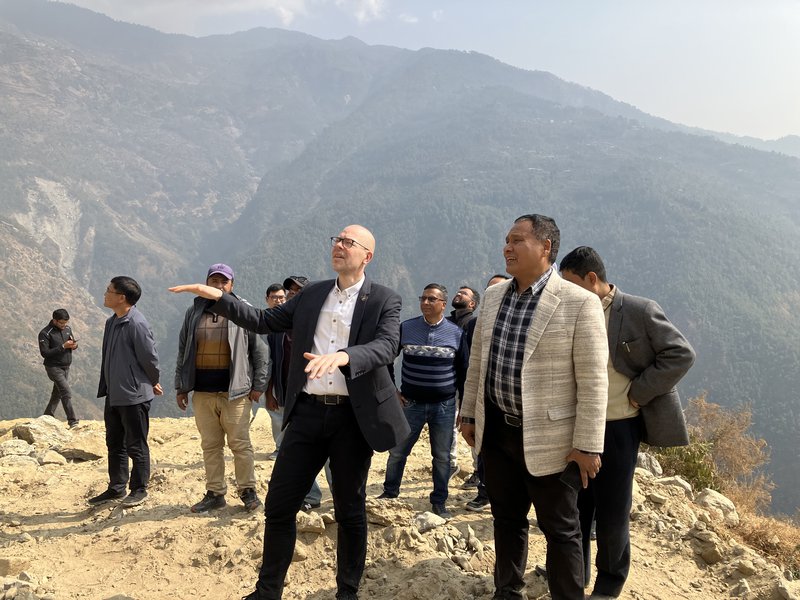
In Nuwakot and Rasuwa, the KFW has given subsidies for electricity, the bolstering of the distribution infrastructure, and solar energy. The Chilime-Trishuli 220 kV transmission line was created to link hydropower facilities being built on the Trishuli river and its tributaries that provide electricity to the national grid.
The project has made 81% of its physical progress so far. Transmission line and substation building are progressing the fastest among them, at 71 and 70%, respectively. To be finished by March of this year, transmission line and substation building is moving forward at top speed.
The support given by the European Union in the transmission project is symbolic at a time when Nepal is undergoing an energy transition, switching from fossil fuel to clean energy for family cooking and transportation.
According to a tweet from the EU, the project has both challenges and opportunities. Once construction is complete, despite the difficulties provided by the mountainous terrain, it would greatly advance Nepal's commitment to clean energy under the SDGs and NDCs until 2050 zero emission.

Keshab Poudel
Poudel is the editor of New Spotlight Magazine.
- HELVETAS NEPAL’S RIVERBED FARMING: Shift From Overseas To Local Farming
- Jul 26, 2024
- POLITICAL SCENARIO : K.P. Sharma Oli's Resurgence
- Jul 21, 2024
- UNDP/MinErgy: An Inventive Approach To Clean Brick Kiln
- Jul 19, 2024
- HELVETAS NEPAL: Nutrition Through Riverbed Farming
- Jul 18, 2024
- NOU Opens To All: Dr. Shilu Manandhar Bajracharya, Vice Chancellor
- Jul 15, 2024
















